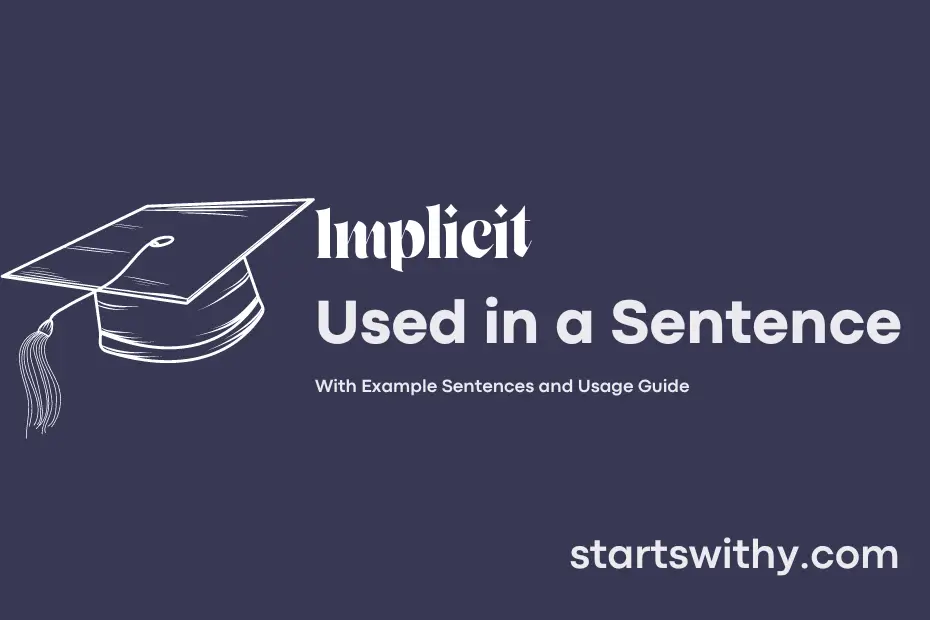Have you ever wondered how subtle messages can be conveyed without being directly stated? That’s where the concept of “implicit” comes into play. Implicit refers to something that is suggested or hinted at without being explicitly expressed.
In language, implicit meanings can be conveyed through context, tone, or cultural references. Understanding implicit messages often requires the reader or listener to infer meaning based on these subtle cues. Let’s dive into how implicit communication works and explore its significance in various contexts.
7 Examples Of Implicit Used In a Sentence For Kids
- Implicit means something that is understood without being said.
- When we follow rules without being told, it is implicit behavior.
- Sharing toys with friends is an implicit way of being kind.
- Listening quietly when someone is speaking is an implicit sign of respect.
- Holding the door open for others is an implicit gesture of politeness.
- Saying “please” and “thank you” is an implicit way to show manners.
- Smiling at someone when they look sad is an implicit way to show we care.
14 Sentences with Implicit Examples
- Implicit in the syllabus is the requirement to submit the assignment by the deadline.
- It is important to understand the implicit instructions given by the professor during lectures.
- There is often an implicit expectation for students to participate actively in group discussions.
- The implicit understanding is that attending all classes will benefit your overall grades.
- Plagiarism is a serious offense that goes against the implicit rules of academic integrity.
- It is implicit that students are responsible for their own research and study habits.
- The professor’s tone can sometimes convey implicit clues about what will be on the exam.
- There is an implicit understanding that only students who attend the tutorial sessions will benefit from additional help.
- Classmates may have implicit agreements about sharing notes and study resources.
- It is implicit in the grading rubric that proper formatting and citations are required in assignments.
- The strict attendance policy is an implicit reminder that regular participation is expected.
- The university’s code of conduct sets forth implicit guidelines regarding student behavior on campus.
- Not following the recommended reading list can result in missing out on the implicit hints for exam questions.
- It is implicit in the academic environment that students should strive for excellence in their work.
How To Use Implicit in Sentences?
To use Implicit in a sentence, you must first understand its meaning. Implicit is an adjective that describes something that is implied or understood without being directly stated. Here is a guide on how to use Implicit in a sentence:
-
Start by identifying a situation where something is suggested or understood indirectly rather than explicitly stated. For example, “Their silence was seen as implicit agreement with the new policy”.
-
Next, determine the context in which you want to use the word Implicit. It can be in a conversation, a written piece, or even in your thoughts.
-
Once you have identified the situation and context, construct a sentence incorporating the word Implicit. Make sure the sentence clearly conveys the idea that something is implied or understood without being directly expressed. For example, “The teacher’s nod was an implicit signal for the students to begin the test”.
-
Finally, read the sentence aloud to ensure it conveys the intended meaning. If needed, you can also check a dictionary or thesaurus to confirm the accuracy of your usage.
By following these steps, you can effectively use the word Implicit in a sentence. Remember to practice using it in different contexts to become more comfortable with incorporating it into your vocabulary.
Conclusion
Implicit sentences are those that convey meaning without explicitly stating it. They rely on context, tone, and reader interpretation to convey the message. These sentences often require the audience to read between the lines and infer the intended meaning. By omitting explicit information, implicit sentences can create a sense of intrigue or mystery, prompting readers to engage more actively with the text.
In literature and everyday communication, implicit sentences can add depth and subtlety to the message being conveyed. They allow for nuance and ambiguity, inviting readers to participate in the process of understanding and interpreting the text. Understanding implicit sentences can enhance one’s ability to grasp underlying meanings and appreciate the art of subtle communication.




